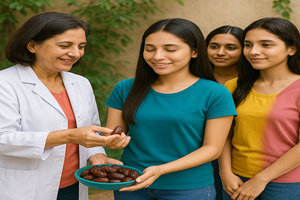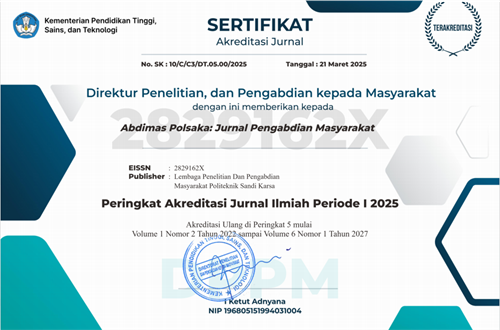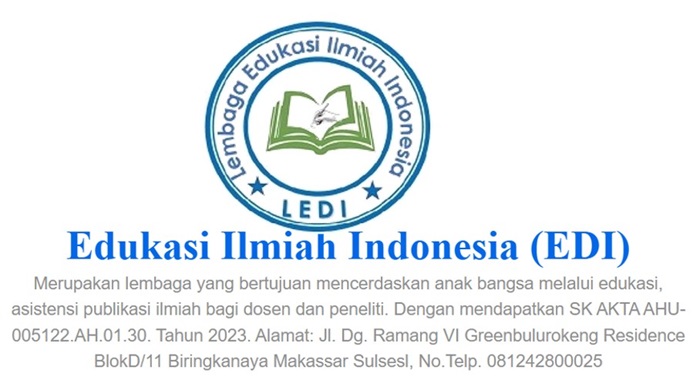Giving dates to young women for the prevention of anemia
DOI:
https://doi.org/10.35816/abdimaspolsaka.v4i2.109Keywords:
Adolescents, Anemia, Hemoglobin, NutritionAbstract
Anemia prevalence among adolescent girls is significantly higher compared to boys, primarily due to menstruation and increased iron requirements during growth. This condition negatively affects immunity, concentration, academic performance, physical fitness, and productivity, and poses long-term health risks, particularly during future pregnancies. In Bone Regency, adolescent anemia rates remain high despite the government’s iron supplementation program. This community service program aimed to implement research findings on using dates (Phoenix dactylifera) to increase hemoglobin levels and address anemia among adolescent girls. The activity involved health education on anemia prevention and the daily provision of 100 grams of dates (7–8 pieces) for seven consecutive days during menstruation. The program was conducted through observation, counseling sessions, and hemoglobin monitoring before and after the intervention. The rationale for using dates is based on their high iron and nutrient content, which supports hemoglobin synthesis naturally. The targeted participants were adolescent girls from the community surrounding Lapatau Stadium, Bone Regency. Expected outcomes included increased knowledge regarding anemia prevention, improvement in hemoglobin levels, and the promotion of alternative nutritional interventions for anemia management. Monitoring and evaluation were conducted by measuring hemoglobin levels post-intervention to assess effectiveness. The program also aims to disseminate results through a SINTA 5-indexed journal publication, providing evidence-based recommendations for integrating date consumption into adolescent nutrition programs. This initiative highlights the potential of locally acceptable, culturally relevant food-based strategies to complement existing public health interventions in reducing anemia prevalence among teenage girls.
Downloads
References
A. Akib and R. Rukinah, “Effect of anemia in pregnant women on the incidence of premature labor and low birth weight,” J. Ilm. Kesehat. Sandi Husada, vol. 13, no. 2, pp. 427–433, Dec. 2024, DOI: https://doi.org/10.35816/jiskh.v13i2.1241
E. Puji Ati et al., “Building anti-stunting youth awareness,” Abdimas Polsaka, vol. 4, no. 1, pp. 37–42, Mar. 2025, DOI: https://doi.org/10.35816/abdimaspolsaka.v4i1.88
D. Arda, N. N. L. N. Lalla, and S. Suprapto, “Analysis of the Effect of Malnutrition Status on Toddlers,” J. Ilm. Kesehat. Sandi Husada, vol. 12, no. 1, pp. 111–116, Jun. 2023, DOI: https://doi.org/10.35816/jiskh.v12i1.910
S. Hardiyanti, “Efektivitas Suplementasi Tepung Daun Kelor dan Bee Bread Terhadap Kadar Hemoglobin, Hematokrit Remaja Putri Anemia,” J. Ilm. Kesehat. Sandi Husada, vol. 11, no. 1, pp. 31–36, Jun. 2022, DOI: https://doi.org/10.35816/jiskh.v11i1.685
R. Ayu Rahmadani, A. Setiawati, I. Aris, A. Lontaan, and P. Prasetyowati, “Effectiveness of nutrition education on stunting prevention behavior in mothers under five,” J. Edukasi Ilm. Kesehat., vol. 3, no. 1, pp. 01–08, Mar. 2025, DOI: https://doi.org/10.61099/junedik.v3i1.68
H. Hatijar, A. Setiawati, L. Situmeang, I. Aris Tyarini, S. Zakiyyah Putri, and L. Yunita, “Balanced nutrition education as an effort to prevent stunting in toddlers,” J. Pengabdi. Masy. Edukasi Indones., vol. 2, no. 2, pp. 39–46, May 2025, DOI: https://doi.org/10.61099/jpmei.v2i2.74
K. S. Phiri et al., “Post-discharge malaria chemoprevention in children admitted with severe anaemia in malaria-endemic settings in Africa: a systematic review and individual patient data meta-analysis of randomised controlled trials,” Lancet Glob. Heal., vol. 12, no. 1, pp. e33–e44, 2024, DOI: https://doi.org/10.1016/S2214-109X(23)00492-8
A. Khare and A. Arora, “From taste to health: Evaluating anemia awareness and consumer acceptance of Iron and protein-rich foods in urban India,” Food Res. Int., vol. 213, p. 116579, 2025, DOI: https://doi.org/10.1016/j.foodres.2025.116579
S. Figueiredo and A. Tereso, “Needs of women that experience pregnancy with an ostomy: A scoping review,” Midwifery, vol. 143, p. 104322, Apr. 2025, doi: https://doi.org/10.1016/j.midw.2025.104322. DOI: https://doi.org/10.1016/j.midw.2025.104322
R. J. Limaye et al., “Exploring COVID-19 vaccination behavior: A cross-country study among pregnant and postpartum women in Brazil, Ghana, Kenya, and Pakistan,” Vaccine, p. 127478, 2025, DOI: https://doi.org/10.1016/j.vaccine.2025.127478
M. Martinelli et al., “Diagnosis and management of anemia in pediatric inflammatory bowel diseases: Clinical practice guidelines on behalf of the SIGENP IBD Working group,” Dig. Liver Dis., vol. 56, no. 8, pp. 1257–1269, 2024, DOI: https://doi.org/10.1016/j.dld.2024.02.016
S. Mettananda and A. S. Athapathu, “1.10 - Iron Deficiency Anemia,” N. B. T.-C. H. and S. C. R. (First E. Rezaei, Ed. Oxford: Elsevier, 2024, pp. 172–195. DOI: https://doi.org/10.1016/B978-0-443-15717-2.00028-7
N. F. Ndiaye et al., “Drivers of anemia reduction among women of reproductive age in Senegal: a country case study,” Am. J. Clin. Nutr., vol. 121, pp. S8–S21, 2025, doi: https://doi.org/10.1016/j.ajcnut.2024.05.031. DOI: https://doi.org/10.1016/j.ajcnut.2024.05.031
C. Prodger and S. Pavord, “Haematology of pregnancy,” Medicine (Baltimore)., vol. 53, no. 4, pp. 257–262, 2025, DOI: https://doi.org/10.1016/j.mpmed.2025.01.008
J. Sharma, S. Devanathan, A. Sengupta, and P. N. Rajeshwari, “Assessing the prevalence of iron deficiency anemia and risk factors among children and women: A case study of rural Uttar Pradesh,” Clin. Epidemiol. Glob. Heal., vol. 26, p. 101545, Mar. 2024, DOI: https://doi.org/10.1016/j.cegh.2024.101545
I. Sverdlichenko, L. Donaldson, and E. Margolin, “Yield of Investigations in Young Patients Presenting With Transient Monocular Vision Loss: A Prospective Study,” Am. J. Ophthalmol., vol. 257, pp. 137–142, 2024, DOI: https://doi.org/10.1016/j.ajo.2023.09.003
J. Velloza et al., “Adaptive HIV pre-exposure prophylaxis adherence interventions for young women in Johannesburg, South Africa: a sequential multiple-assignment randomised trial,” Lancet HIV, vol. 12, no. 2, pp. e105–e117, 2025, DOI: https://doi.org/10.1016/S2352-3018(24)00268-6
D. Yilma et al., “Safety and efficacy of single-dose primaquine to interrupt Plasmodium falciparum malaria transmission in children compared with adults: a systematic review and individual patient data meta-analysis,” Lancet Infect. Dis., 2025, DOI: https://doi.org/10.1016/S1473-3099(25)00078-7
T. Vey, E. Kinnicutt, N. West, J. Sleeth, K. B. Nchimbi, and K. Yeates, “Implementation of a Mobile Health Approach to a Long-Lasting Insecticidal Net Uptake Intervention for Malaria Prevention Among Pregnant Women in Tanzania: Process Evaluation of the Hati Salama (HASA) Randomized Controlled Trial Study,” J. Med. Internet Res., vol. 26, 2024, DOI: https://doi.org/10.2196/51527
R. Roopak, S. Chakrabarti, and N. Sreen, “Engaged to Gain: How psychological needs drive integrative benefits via online customer engagement,” J. Retail. Consum. Serv., vol. 87, p. 104383, 2025, DOI: https://doi.org/10.1016/j.jretconser.2025.104383
Y. Shang and X. (Robert) Luo, “An empirical investigation of users’ engagement in online health communities for chronic diseases,” Inf. Manag., vol. 62, no. 8, p. 104213, 2025, DOI: https://doi.org/10.1016/j.im.2025.104213

Additional Files
Published
How to Cite
Issue
Section
License
Copyright (c) 2025 Indryani Indryani, Mustar Mustar, Hasnidar Hasnidar, Pattola Pattola, Sulfianti Sulfianti

This work is licensed under a Creative Commons Attribution 4.0 International License.
Most read articles by the same author(s)
- Yani Maidelwita, Yoga Tri Wijayanti, Nurafriani Nurafriani, Indryani Indryani, Heni Selvia, Tri Maya Cahya Mulat, Balanced nutrition education to prevent stunting in children , Abdimas Polsaka: Vol. 3 No. 2 (2024): Abdimas Polsaka: Jurnal Pengabdian Masyarakat




















